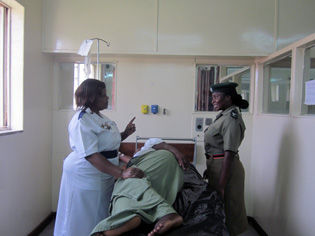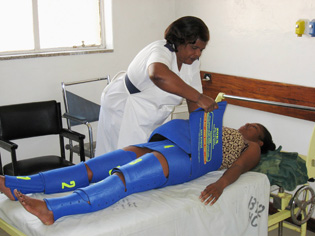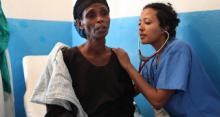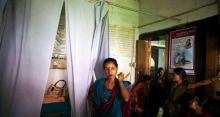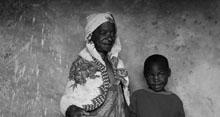Hero: Rhoda Amafumba
Heroes
Exclusive one-on-one interviews with extraordinary individuals working on behalf of women, children, and families worldwide.
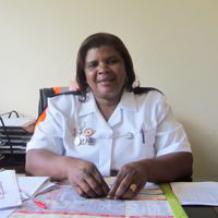
HER DREAM
WHY SHE’S A HERO
Rhoda Amafumba has been working as a dedicated midwife and nurse for more than 25 years. She works at the university teaching hospital in Lusaka, Zambia. The leading cause of maternal death is obstetric hemorrhage, when women bleed to death before they get the care they need. Rhoda trains midwifes in use of the LifeWrap, a groundbreaking first-aid device that saves mothers’ lives.
A CHAT WITH HERO RHODA AMAFUMBA
IMOW: Rhoda, can you tell me how you became a midwife and an advocate for maternal health?
Rhoda: I believe it was a calling. Seeing a delivery for me, if you’re a Christian, it makes you feel connected to God’s creation. The feeling when a baby has been delivered, before the parents see the baby and you are the first person to see the baby brings so much excitement, and you just feel like continuing to do the best you can for this mother and the baby.
IMOW: Kind of a labor of love?
RHODA: I’m supposed to work from 7:30 am to 4 o’clock pm. But believe me, it’s almost impossible to leave at sixteen hours. It’s almost impossible. Sometimes when you are just thinking of leaving the ward, that’s when probably you have PPH (Post Partum Hemorrhage) coming, that’s when you are having a patient who is havingeclamptic seizures, how can you leave the patient? You just continue working. The night nurses sometimes left me in the morning, then they come back for work at 6:00 pm and they find me; I’m still in the ward.
IMOW: What exactly is the LifeWrap, and how does it work?
RHODA: The LifeWrap is sometimes compared to a wet suit—like you would use in diving underwater. It’s a non-pneumatic anti-shock garment (NASG), a neoprene compression first-aid device that is designed to stop bleeding and maintain blood pressure. A nurse can wrap it tightly around a woman who is bleeding and save her life. Sometimes you’ll have a patient that has come from a rural clinic and she’s bleeding,nd you have to manage to control this bleeding, and this patient is in shock. And there’s no blood for transfusions sometimes, so what do you do? This is where this garment has become so handy. You apply the garment, and instantly the vital signs improve. It gives you chance to run around, to look for blood, to call for donors. It gives us more time, so that we can find blood and we can transfuse this woman.
IMOW: Such a simple, but profound way to save a life—do patients recognize this?
Rhoda: There are times when you apply a LifeWrap garment, and the woman is not talking. Immediately you apply the garment and this woman says, “I’m feeling much better now.” Believe me, sometimes you can feel tears coming, because sometimes you have even said to yourself: “Will this woman make it?” And then you apply the garment. This woman is unconscious, you apply the garment, and you start to transfer her to the ICU. But by the time the midwives start the transfer to ICU, they come back down the hall laughing. “Sister your patient is talking.” Yes, talking from being unconscious. You apply the garment, rush to ICU, by the time they reached ICU this patient was talking. The following morning she was out of ICU back to where we had applied the garment. I went to see her and she kept on saying, “This thing saved my life.” I said, “We have to do what we did for you, we are happy that you are alive.”
IMOW: What are your most challenging times?
Rhoda: If you walk in the morning and the ladies in the night had a maternal death, as you enter the ward, you can tell things are not fine. Because whatever food the ladies carried for their night, you find it packed on the table. And you look at their faces, they are gloomy. I ask them if they are okay. They say: “We are not fine, we had a maternal death.” Everybody is sad. It’s very, very frustrating when we know we can save their lives. We all know they need not die, what is killing them is preventable.
IMOW: How do you encourage your student midwives?
Rhoda: I urge the midwives to do their best. I know they work under very, very difficult conditions. But at the end of the day if you are able to save a life, it will make you happy. It’s saving the lives of these women that we chose to care for that will make us happy.
IMOW: Tell me something about yourself that you think people would be surprised to hear.
Rhoda: Sometimes I joke that—and I’ve actually told this to the girls who I work with—if somebody came here from home and found me running around in this labor ward, they would be surprised because I’m actually a lazy person at home!
IMOW: I find that hard to believe, clearly you work very hard!
Rhoda: I work so much at work, but when I go home, believe me, all I do is sit. Yes. I enjoy having my breakfast in bed. (Laughing.)
Special thanks to Dr. Suellen Miller, Director, Safe Motherhood Programs Bixby Center for Global Reproductive Health and Policy, for conducting this interview for IMOW.
Take Action
Help Rhoda in her work to improve decrease maternal mortality with midwifery training and use of the LifeWrap.
Related Content
|
Dr. Rahel Nardos is improving maternal health in Ethiopia one woman at a time, by training Ethiopian doctors and midwives in life-saving obstetric procedures and preventative maternal health. |
Christy Turlington Burns explains that in order to make true progress on maternal health, we need to collectively prioritize mothers and advocate on their behalf. |
This photo essay depicts pregnant women in Nepal and introduces us to the men and women who guide mothers through a healthy delivery. |
Sasja van Vechgel, alongside the Foxes NGO, photographed mothers, children, and families affected by the HIV/AIDS endemic in Tanzania. |


